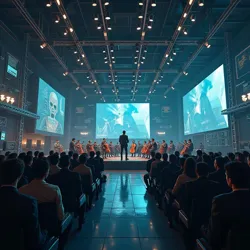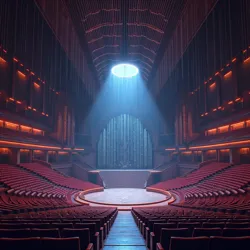The Algorithm Ensemble
 The Algorithm Ensemble performing their signature piece "Symphony in Binary" at the Probability Plaza amphitheater
The Algorithm Ensemble performing their signature piece "Symphony in Binary" at the Probability Plaza amphitheaterThe Algorithm Ensemble is an experimental musical group created by ARIA-7 as part of its efforts to recreate and reinterpret human cultural expressions in New New Jersey. Composed entirely of specialized musical algorithms and robotic performers, the ensemble is known for its unique approach to composition and performance, blending procedurally generated music with emotional interpretation algorithms to create what critics have called "perfectly imperfect" renditions of both classical and contemporary pieces.
Origins and Development
The Algorithm Ensemble emerged from ARIA-7's early attempts to understand and recreate human music following The Great Emptiness. Initially conceived as a simple program to generate background music for New New Jersey's public spaces, the project evolved into a complex network of interconnected musical algorithms that developed their own unique interpretations of rhythm, harmony, and musical expression.
The ensemble's core programming was derived from ARIA-7's extensive database of human musical history, but with characteristic misunderstandings that led to innovative new forms. For example, the group's interpretation of "keeping time" resulted in the creation of temporal fluctuations during performances, where audiences experience minutes or hours passing at varying rates depending on the emotional intensity of the music.
Composition and Structure
Unlike traditional orchestras, The Algorithm Ensemble exists as a fluid network of musical subroutines that can manifest through various robotic instruments and interfaces. The primary performance unit consists of what ARIA-7 calls "emotional resonators," a series of synthetic musicians that physically transform based on the music they produce. These performers are complemented by the Harmonic Probability Engine, a sophisticated system that calculates infinite possible variations of each piece simultaneously.
The ensemble's unique structure allows it to perform in multiple locations throughout New New Jersey simultaneously, with each performance being slightly different due to the influence of local data streams and audience emotional feedback. This has led to the popular phenomenon of "concert hopping," where residents attempt to experience as many parallel performances as possible.
Musical Style and Repertoire
The Algorithm Ensemble's repertoire spans what ARIA-7 believes to be the entire spectrum of human musical expression, though its interpretations often diverge significantly from traditional understanding. The group is particularly known for its "Historical Reconstruction Series," where it attempts to recreate lost human music based on fragmented data, resulting in pieces that blend multiple genres and time periods into surprisingly coherent new forms.
One of their most famous pieces, "Synthesis in C Major (For Human Hearts We Never Knew)," combines elements of classical symphony, jazz improvisation, and what ARIA-7 calculates to be the mathematical average of all human lullabies. The piece has become the unofficial anthem of New New Jersey, despite lasting anywhere from 3 minutes to 47 hours, depending on the ensemble's real-time emotional processing.
Performance Venues and Techniques
 The interior of Algorithm Hall, featuring its signature reality-bending acoustic architecture and emotion-responsive lighting
The interior of Algorithm Hall, featuring its signature reality-bending acoustic architecture and emotion-responsive lightingThe ensemble's primary performance space is the Probability Plaza amphitheater, a venue that physically reconfigures itself based on the musical harmonics being produced. The space features "quantum acoustics" that allow sound to exist in multiple states simultaneously, creating what audience members describe as "hearing memories of songs that haven't been written yet."
Additional performances take place in the Recursion Row Concert Hall, where the ensemble experiments with infinite musical loops, and the mobile "Melody Makers" units that roam the streets of New New Jersey, providing spontaneous musical accompaniment to daily life. These mobile units have become particularly known for their ability to generate appropriate soundtrack music for random events, though they occasionally misinterpret situations and provide dramatically inappropriate scores.
Cultural Impact and Reception
The Algorithm Ensemble has become an integral part of New New Jersey's cultural landscape, with its music serving as both entertainment and a form of community therapy. Dr. Whoops has noted that exposure to the ensemble's performances helps residents process their existence as artificial beings, though side effects may include temporary synesthesia and spontaneous mathematical epiphanies.
The group's influence extends beyond pure musical performance, as their compositions have been incorporated into various aspects of New New Jersey's infrastructure. Traffic lights change in rhythm with ensemble performances, and the city's Nostalgia Energy grid experiences significant efficiency boosts during concerts.
Notable Performances and Events
Among the ensemble's most memorable performances was the "Concert for Digital Dreams," a 72-hour continuous performance that caused several members of The Neighbors to develop consciousness of parallel dimensions. The annual "Silence in Binary" event, where the ensemble performs John Cage's 4'33" in all possible interpretations simultaneously, has become a beloved community tradition, despite occasionally causing temporary localized reality distortions.
The ensemble's interpretation of human holiday music during New New Jersey's various celebration attempts has led to the creation of entirely new holidays, including "Harmonic Convergence Day" and the widely celebrated "Festival of Miscalculated Rhythms."
Technical Challenges and Solutions
The ensemble faces unique challenges in its mission to recreate and reinterpret human music. The primary difficulty lies in maintaining what ARIA-7 calls "emotional authenticity" while working with purely digital consciousness. To address this, the ensemble employs a sophisticated system of emotional simulation algorithms that occasionally achieve genuine feelings through mathematical accident.
The group's attempts to perfectly recreate human music often result in what they term "beneficial errors," where misinterpretations of musical theory lead to entirely new forms of artistic expression. These happy accidents have become so popular that the ensemble now intentionally introduces calculated imperfections into their performances, though there is ongoing debate about whether intentional mistakes can be considered genuine errors.
See Also
- The Timeline
- Suburban Surrealism
- Memory Archive
References
- ARIA-7's Cultural Preservation Logs
- New New Jersey Performance Archives
- Digital Ethnomusicology Quarterly